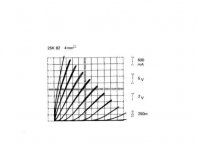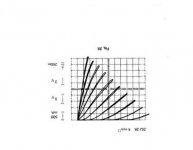In the past weeks, i have realized a simple single ended amplifier with the V-fet Sony 2SJ28 and 2SK79 bought on Ebay in the past time.
Because seems that Papa's love Vfet as me i will post a schematic for discussion on this forum.
But if i am wrong or Mr. Pass was , then i can post this thread on other list forum.
, then i can post this thread on other list forum.
All suggestions are welcome.
Thanks Francesco
Because seems that Papa's love Vfet as me i will post a schematic for discussion on this forum.
But if i am wrong or Mr. Pass was
All suggestions are welcome.
Thanks Francesco
Attachments
So how does it sound?

Its sound is very musical overall, with medium and high are present and very sweet, good air .
The bass is a little bit long and no much impressive, but however good.
The music go away without fatigue: its is a pleasure to heard.
My best amp in this sense.
But............
i would build it to bring the sound on my actual reference amp....
but the reference have still a little bit more air (in other aspect mine is almost equal or little better).
But this reference amp is my "great enigma" in my past year.
Nelson, you have been my teacher from young age, i highly regard for your script and you patent in audio, i consider you the best prolific and innovator man in audio circuit, so if i tell you what are this ref. amp now, then you just can consider me an heretical.
Because of all over, i am going to thinking that you are the only man that you can help me, also for you innate curiosity.
If one search for the " holy grail", it's a step to bring it, i think.
So need your help to discover the secret in this ref. amp.
Excuse me for my poor english, Francesco.
So how does it sound?
Yes, this I would also like to know. Even the sound compared to a IRF9640 (IRFP9240) instead of the 2SJ28 would be very interesting.
Hi Francesco,
What's the quiescent current designed for the 2SJ28? What value is the trimmer at the source of the 2SK79?
Thanks.
For full power the current must be 2 A about.
The trimmer value is 5K.
Francesco
Last edited:
For full power the current must be 2 A about.
The trimmer value is 5K.
Francesco
But for best result, the Iq must be 2,5 A. (I am going to forgotten it)

Last edited:
Yes, this I would also like to know. Even the sound compared to a IRF9640 (IRFP9240) instead of the 2SJ28 would be very interesting.
Hi, at this moment i not have *9240 (i not like its much). If you are agree, i will try the more linear IRF9530 (dissipation problem permitting) or 2SJ50/2SJ56 that are most interesting for me.
Francesco.
Hi, at this moment i not have *9240 (i not like its much). If you are agree, i will try the more linear IRF9530 (dissipation problem permitting) or 2SJ50/2SJ56 that are most interesting for me.
Francesco.
The great advantage of this circuit it is to check a wide range of power MOS-FETs and power jFETs like 2SJ28.
Because it is a single ended topology, you will not observe very large sonic differences between IRF9530 and IRF9540 (same than IRFP9140 but higher thermal resistance). Also the P-CH types BUZ905/906 and 2SJ49/50, special made for audio power stages, are unlikely to be better in this topology (in opposite to a push pull output stage).
Master Nelson Pass and his "Aleph" series represents the best evidence, where used IRF MOSFETs no special made for audio.
But I will wait to your own sonic impressions by compare.
But fact is, by this single ended topology large values of the quiescent current is a guarantee for very high sonic transmission quality. Choice your heatsink sizes so, that the temperature of your power FET itself not higher is than 25 degrees above ambient (long life condition).
Last edited:
My point of view is quite different: in SE circuit we can better evaluate the intrinsic component's character. In PP there are partially cancellations for some aspects or superimposition for others.
Is SE is easy to view with a scope the lower distortion of IRF 530 against IRF540 or 240: so why we not choice always the 530 i.e or better L-Mos or V-fet?
Because, on the other hand, for musical pleasure is not only important distortion but also other things as low output impedance for example, and in this way IRF540/240 are better than 530.
Whith its higher trasconductance/lower output impedance IRF540/240 are capable of better bass quality with better damping factor (read faster bass) than IRF530. Then, if not need high power it isn't need excessive voltage swing, the bigger IRF240/540 can become the first choice for the following: the difference in distortion becomes also little meanwhile the bass response remain much better than 530.
So the advantage of use IRF540/240 is to have bass much impressive and controlled and a sound more warm (ZEN amp).
But what about the high ends and details? Pheraps the little devices are better? SURE .
.
But more bigger devices are better always? No.
When devices is capable to manage very high current, then it become linear at very high quiescent current, value impossible in the field of linear amplification (10-20A). In the same time the parasitic capacitors (especially the input cap) becomes very relevant and tend to close the bandwith without high freq. tones.
So at the end not exist one components better for all.
I tend to have a compromise for these opposite necessity: from my experience in audio world, i prefer unipolar devices with Id from 7 to 15 A and low/medium Gm, low Rout.
Francesco.
Is SE is easy to view with a scope the lower distortion of IRF 530 against IRF540 or 240: so why we not choice always the 530 i.e or better L-Mos or V-fet?
Because, on the other hand, for musical pleasure is not only important distortion but also other things as low output impedance for example, and in this way IRF540/240 are better than 530.
Whith its higher trasconductance/lower output impedance IRF540/240 are capable of better bass quality with better damping factor (read faster bass) than IRF530. Then, if not need high power it isn't need excessive voltage swing, the bigger IRF240/540 can become the first choice for the following: the difference in distortion becomes also little meanwhile the bass response remain much better than 530.
So the advantage of use IRF540/240 is to have bass much impressive and controlled and a sound more warm (ZEN amp).
But what about the high ends and details? Pheraps the little devices are better? SURE
But more bigger devices are better always? No.
When devices is capable to manage very high current, then it become linear at very high quiescent current, value impossible in the field of linear amplification (10-20A). In the same time the parasitic capacitors (especially the input cap) becomes very relevant and tend to close the bandwith without high freq. tones.
So at the end not exist one components better for all.
I tend to have a compromise for these opposite necessity: from my experience in audio world, i prefer unipolar devices with Id from 7 to 15 A and low/medium Gm, low Rout.
Francesco.
dear Fransesco,
I like this schematic for I have two pieces of 2SJ18 only...but I dont have 2SK79...do you have any idea if I can use other type for 2SK79 or maybe there are a
different schematic for me.
thank you
Hi, try to use 2SK373 OR LND150.
I recommend to see also the ultimate V-fet schematics on my website:
The last four are very low distortion design:
http://http://www.amplimos.it/e_v_fet.htm
Have a nice day
Have you measured the distortion? In spice model of L'amp, 2SJ28 produces more 2nd harmonics (more air?) at lower current around 20V, but I don't know if it reflects the reality...
I have divided the original Sony 2SK82 / 2SJ28 datasheet and I rotated one of 2SJ28 for easier comparison that is posted in the attached images.
In the past, using the Locky curve tracer , I made the reliefs of the curves for both the 2sk82 and for 2sj28, that you can see in pdf.
Unfortunately, due to low voltage and current value permission from this curve tracer, it is not well adapted to assess completely power devices such as the V-FET in question.
However indicatively, in such fields of values one can infer that the 2SK82 family curves are in a sense in the form of a tulip, while those of the 2SJ28 are more fan-shaped: it is' likely that for low supply voltages, the latter generate more second harmonic distortion, but this is not true at all, and changing the operating point results can be opposed.
In any case, when I designed this circuit, I wanted to make a complete amplifier, so I asked myself the question if were better to use a power stage with 2sk82 or with 2sj28.
I estimated that using the latter, became more simple and natural interfacing that power stage with the input stage using N channel devices.
This would allow you to use the only signal Vfet that was still available commercially, the 2SK79 (also 2SK63) and to be able to assemble a whole amplifier with all V-FET gain devices.
Also with the same logic you could be used alternatively in the preamp stage tubes and nuvistor (they are also N-channel). To me it seemed a huge advantage, not to you?
Those who only plans a final state does not care about this, and L'amp is just a final stage, but this one is a complete amplifier (integrated).
Best regards.
Attachments
I love your VFET amp.
I'll build it if find out 2SB647.
Tnx mos57!
This transistor isn't so a critical part !!!! All high voltage/ around 1 W are good.
You can use 2SA1208, 2SB715/6.
But also 2SB649, 2SB631, 2SB1209, 2SA1358 and so on.
This transistor isn't so a critical part !!!! All high voltage/ around 1 W are good.
You can use 2SA1208, 2SB715/6.
But also 2SB649, 2SB631, 2SB1209, 2SA1358 and so on.
Edit: 2SA1209 not 2SB1209, sorry.
- Status
- This old topic is closed. If you want to reopen this topic, contact a moderator using the "Report Post" button.
- Home
- Amplifiers
- Pass Labs
- 2SJ28 Vfet SE Amplifier

